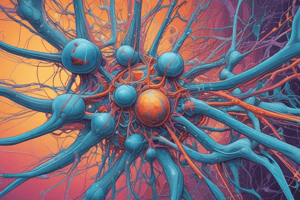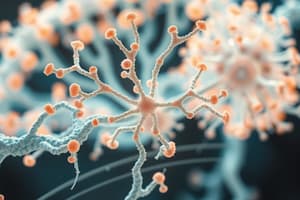Podcast
Questions and Answers
What is the primary function of the cytoskeleton in eukaryotic cells?
What is the primary function of the cytoskeleton in eukaryotic cells?
- Providing support and enabling movement (correct)
- Storage of nutrients
- Facilitating endocytosis
- Regulating metabolic processes
In what type of cells are microtubules primarily found?
In what type of cells are microtubules primarily found?
- Plant cells
- Animal cells (correct)
- Fungal cells
- Bacterial cells
Which of the following best describes the role of vacuoles in plant cells?
Which of the following best describes the role of vacuoles in plant cells?
- Store nutrients, ions, water, and waste materials (correct)
- Help in cell division during mitosis
- Function as a defense mechanism against predators
- Transport materials to and from the Golgi apparatus
What distinguishes flagella from cilia?
What distinguishes flagella from cilia?
What is the function of endosomes within a cell?
What is the function of endosomes within a cell?
What is the primary function of the Rough Endoplasmic Reticulum (RER)?
What is the primary function of the Rough Endoplasmic Reticulum (RER)?
What is the primary role of organelles within a cell?
What is the primary role of organelles within a cell?
Which of the following accurately describes the Golgi apparatus?
Which of the following accurately describes the Golgi apparatus?
Which type of cell lacks a defined nucleus?
Which type of cell lacks a defined nucleus?
What is the main role of mitochondria within a cell?
What is the main role of mitochondria within a cell?
Which function is exclusive to chloroplasts?
Which function is exclusive to chloroplasts?
Which structure is primarily involved in protein synthesis?
Which structure is primarily involved in protein synthesis?
What is the function of the Golgi apparatus?
What is the function of the Golgi apparatus?
Which organelle is primarily involved in cellular digestion?
Which organelle is primarily involved in cellular digestion?
Which of the following cells is characterized by having a rigid cell wall?
Which of the following cells is characterized by having a rigid cell wall?
What roles do peroxisomes play in a cell?
What roles do peroxisomes play in a cell?
What is the significance of maintaining cellular shape?
What is the significance of maintaining cellular shape?
What component of a cell is primarily responsible for energy supply?
What component of a cell is primarily responsible for energy supply?
What distinguishes prokaryotic cells from eukaryotic cells?
What distinguishes prokaryotic cells from eukaryotic cells?
What is NOT a function of the Smooth Endoplasmic Reticulum (SER)?
What is NOT a function of the Smooth Endoplasmic Reticulum (SER)?
Which cell type is heterotrophic and has a chitin cell wall?
Which cell type is heterotrophic and has a chitin cell wall?
What is the primary function of the cell membrane?
What is the primary function of the cell membrane?
In plant cells, where is the cell membrane located?
In plant cells, where is the cell membrane located?
What is contained within the nucleolus?
What is contained within the nucleolus?
Which organelle is responsible for synthesizing protein molecules?
Which organelle is responsible for synthesizing protein molecules?
What characterizes the endoplasmic reticulum?
What characterizes the endoplasmic reticulum?
What substance occupies the intracellular space between the cell membrane and the nucleus?
What substance occupies the intracellular space between the cell membrane and the nucleus?
Which of the following organelles serves as the control center of the cell?
Which of the following organelles serves as the control center of the cell?
What role do proteins play in the cell?
What role do proteins play in the cell?
Flashcards are hidden until you start studying
Study Notes
Cytoskeleton
- Composed of protein filaments: microtubules, microfilaments, and intermediate filaments.
- Provides structural support and enables movement in eukaryotic cells.
Flagella and Cilia
- Flagella are elongated structures enabling locomotion in liquid; cilia are shorter and create coordinated flows on the cell surface.
Centrosomes
- Organize spindle fibers during cell division in mitosis and meiosis.
- Present in animal cells.
Microtubules
- Serve as structural components and are crucial during cell division.
- Exclusively found in animal cells.
Storage and Transportation
- Manage nutrients, eliminate waste, and regulate metabolic processes.
Vacuoles
- Membrane-bound organelles in plant and some animal cells.
- Store nutrients, water, ions, and waste while regulating turgor pressure and osmotic balance.
- Involved in substance digestion and serve as a defense mechanism by containing toxins.
Vesicles and Endosomes
- Membranous structures that transport specific materials between organelles and cell membranes.
- Vesicles transport materials from endoplasmic reticulum and Golgi apparatus.
- Endosomes capture and distribute materials for degradation, recycling, or incorporation into metabolic pathways.
Differences Between Plant and Animal Cells
- Plant cells have a cell wall; animal cells have only a cell membrane.
- Plant cells contain larger vacuoles; animal cells contain centrioles.
Endoplasmic Reticulum (ER)
- Rough ER: Studded with ribosomes for protein synthesis and modification.
- Smooth ER: Specializes in lipid synthesis, carbohydrate metabolism, and detoxification.
Golgi Apparatus
- Composed of flattened sacs called cisternae.
- Functions as the 'shipping center' of the cell, sorting and packaging proteins into vesicles for transport.
Mitochondria
- Present in both animal and plant cells.
- Generate energy via cellular respiration (ATP production) and have a double membrane structure for respiratory chain organization.
Chloroplasts
- Exclusive to plant cells; conduct photosynthesis to convert solar energy into chemical energy.
- Synthesize glucose and release oxygen as a byproduct.
Cellular Digestion
- Involves breaking down molecules and unwanted materials for recycling and maintenance.
Lysosomes
- Contain digestive enzymes that break down cellular materials and nutrients, including bacteria and damaged cells.
Peroxisomes
- Detoxify harmful molecules and break down hydrogen peroxide.
- Involved in lipid metabolism and regulating overall homeostasis.
Cell Membrane
- Outer layer composed of phospholipid bilayer embedded with proteins.
- Regulates passage of substances, acting as a selective barrier.
Cell Wall (in Plants)
- Strong outer layer that protects and maintains internal structure.
Cytoplasm
- Gel-like substance containing water, salts, proteins, and other molecules.
- Occupies space between the cell membrane and nucleus.
Nucleus
- Central organelle within eukaryotic cells; stores and safeguards DNA.
- Controls gene expression and DNA replication.
Nucleolus
- Found inside the nucleus; consists of RNA and protein.
- Involved in ribosome synthesis and looks like a smaller nucleus.
Ribosomes
- Essential for protein synthesis, found in cytoplasm and rough ER.
- Known as the "protein builders" of the cell.
Endoplasmic Reticulum
- Network of membranes extending from the nuclear membrane to the cell membrane.
- Fundamental for transport, processing, and distribution of proteins and lipids within the cell.
Studying That Suits You
Use AI to generate personalized quizzes and flashcards to suit your learning preferences.




